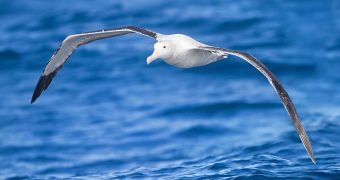When hungry and foraging for food, albatrosses tend to use flight paths whose patterns remind experts of fractals. What this suggests is that mathematics can be used to predict how these birds fly over the ocean when they are searching for food.
In a paper published in the April 23 online issue of the esteemed journal Proceedings of the National Academy of Sciences (PNAS), investigators describe how the fractal-like flight plans help the large marine birds find nourishment.
What is very interesting about the mathematical pattern that the birds follow is that it tends to repeat itself at smaller and smaller scale. In simple terms, a fractal is a self-similar pattern, which looks the same regardless of the scale from which it's being viewed, Science News reports.
This type of movement has been dubbed Lévy flight. Investigators believe that it is extremely efficient at finding scarce prey, while at the same time covering a lot of surface. The albatrosses use a series of movements over a small area, then fly away for a bit, and repeat the same sequence.
“Think about searching for your car keys. You intensively search in one area, but if you don’t find them there, you jump to someplace else and search there,” says behavioral ecologist David Sims, who holds an appointment with the Marine Biological Association of the United Kingdom, in Plymouth.
Lévy flights were first described in the top journal Nature back in 1996, by physicists at the Boston University. However, the data the British Antarctic Survey provided at the time were incomplete.
The new investigation was conducted by attaching GPS devices on 88 albatrosses, and releasing the birds into the wild. The locators were sensitive enough to make up the smaller-scale flight patterns the birds used while scanning the ocean for food.
But some experts do not agree with the new conclusions. Critics say that the birds may in fact be using a composite approach to foraging, combining Lévy flights with Brownian (random) motions and flying in a straight line.
Since the study was conducted statistically, there is more than one way of interpreting the results. In the future, more direct observations could reveal the truth about albatross foraging patterns and habits.

 14 DAY TRIAL //
14 DAY TRIAL //